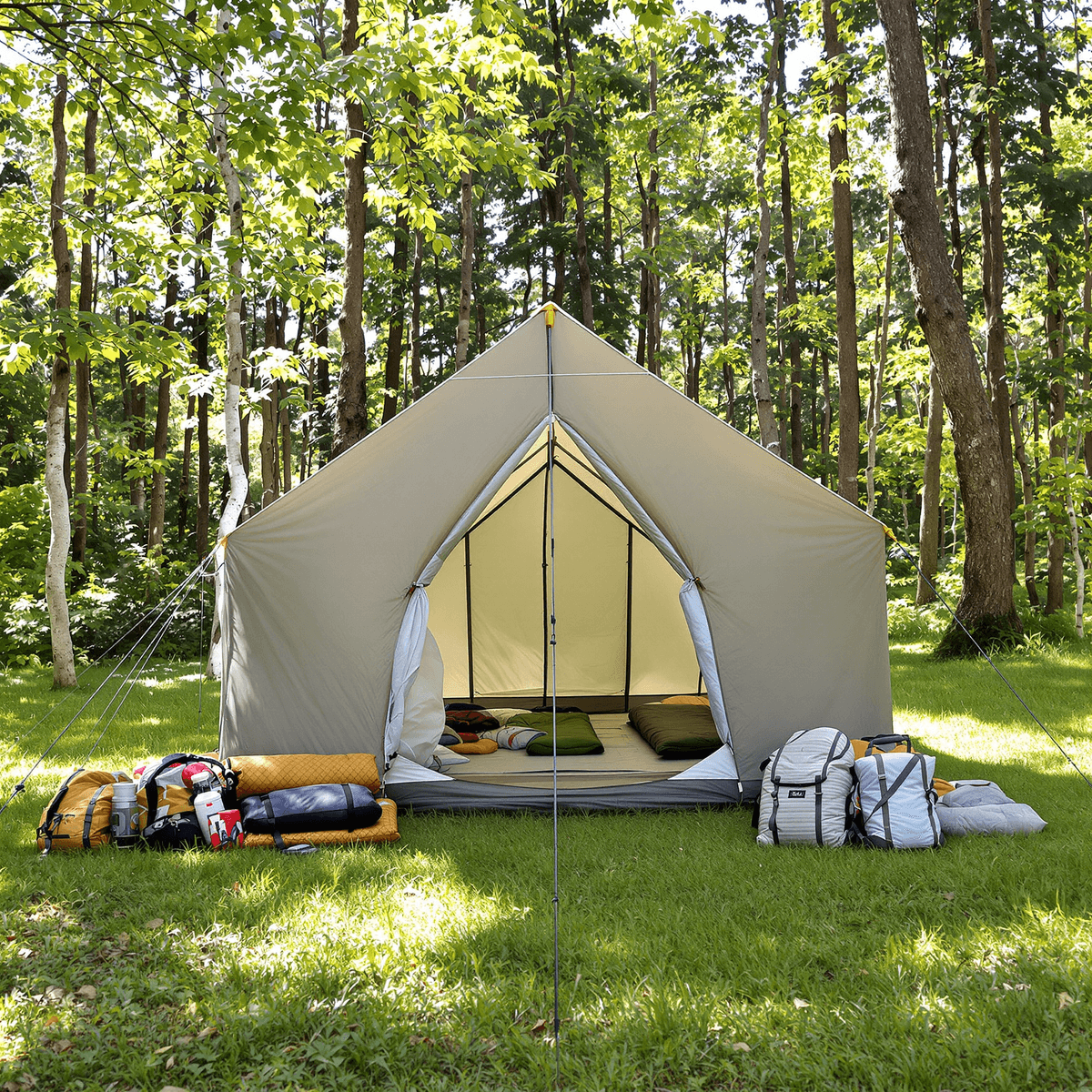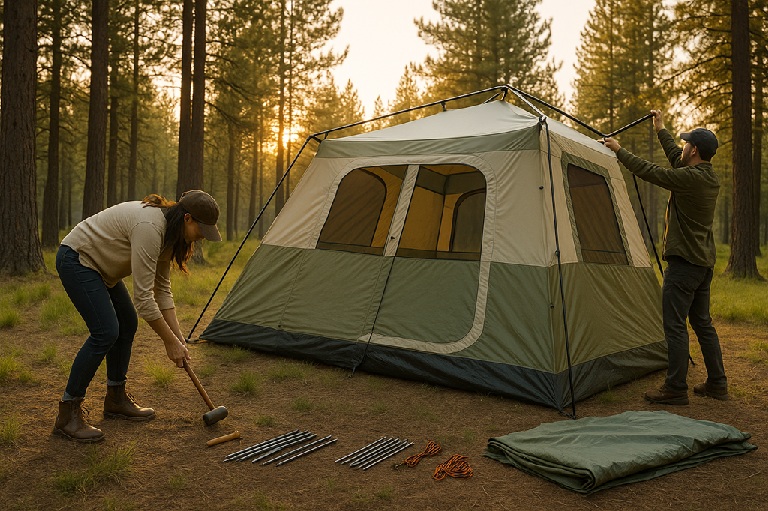This blog post may contain affiliate links. As an Amazon Associate I earn from qualifying purchases.
Cabin tents have become a go-to choice for campers who value space, comfort, and protection from the elements. These camping shelters offer vertical walls that maximize interior room, allowing you to stand upright and move freely—a luxury you won’t find in traditional dome tents. Whether you’re planning a weekend getaway with family or a solo adventure in the wilderness, mastering cabin tent setup transforms your camping experience from frustrating to enjoyable.
How to pitch a cabin tent? This question often intimidates first-time users, but the process is more straightforward than you might think. With the right approach, you can have your shelter ready in under 15 minutes. The key lies in understanding the components, following a systematic approach, and practicing before you head into the backcountry.
In this guide, we’ll walk you through a step-by-step process on how to pitch a cabin tent efficiently and correctly. You’ll learn preparation techniques, assembly methods, and troubleshooting tips that ensure your tent stands strong against wind and weather.
Also Read: 10 Best Cabin Tent for Wind And Rain: Stay Dry and Secure
Understanding Cabin Tents

Cabin tents are vertical-walled shelters that maximize interior space, creating a room-like environment that sets them apart from traditional dome or tunnel designs. These spacious camping tents feature near-vertical walls that allow you to stand upright and move comfortably throughout the interior, making them feel less like a cramped shelter and more like a temporary home away from home.
Key Features of Cabin Tents
The defining cabin tent features include:
- Substantial height—often reaching 6 to 7 feet at the center
- Boxy, rectangular floor plan that eliminates wasted space in the corners
- Weather-resistant construction with reinforced seams, heavy-duty zippers, and robust fabric materials
- Multiple windows with mesh panels for ventilation while keeping insects out
Versatile Uses of Cabin Tents
Cabin tents serve diverse camping scenarios with remarkable adaptability. You can use them for:
- Extended family camping trips where multiple people need comfortable sleeping arrangements
- Base camp setups for hiking or fishing expeditions
- Music festivals and outdoor events requiring temporary shelter
- Backyard camping experiences for children
- Emergency housing situations
Benefits for Campers
Solo campers appreciate cabin tents for the extra room to organize gear and create distinct living zones, while groups benefit from the ability to fit multiple sleeping bags or cots without feeling cramped. The generous headroom means you can change clothes standing up, set up folding chairs inside during bad weather, and generally enjoy a more civilized camping experience than smaller tent styles provide.
Preparing to Pitch Your Cabin Tent
Before you start assembling your shelter, proper cabin tent preparation sets the foundation for a successful setup. You’ll want to empty your tent bag completely and spread out all components on a clean, flat surface. This camping gear checklist moment allows you to verify that every piece is accounted for—poles, stakes, rain fly, ground tarp, and any additional hardware.
Inventory Your Tent Parts:
- Tent body and fabric panels
- Pole sections (spring rods, T-poles, upright supports)
- Stakes and guy lines
- Ground tarp or footprint
- Rain fly and awning components
- Aluminum sleeves and connectors
Selecting your campsite location requires careful consideration. You need level ground free from rocks, roots, and debris that could damage your tent floor or create uncomfortable sleeping conditions. Look for natural drainage patterns—you don’t want to pitch your tent in a spot where water pools during rain.
The orientation of your tent entrance matters significantly. Position the door away from prevailing winds to prevent gusts from blowing directly into your living space. Consider the sun’s path throughout the day—you might want morning sunlight to warm your tent or prefer shade during hot afternoons. Take note of nearby trees that could provide natural windbreaks or shade, but avoid areas directly beneath dead branches or trees that could pose hazards.
Step-by-Step Guide to Pitching a Cabin Tent
Now that you’ve prepared your site and organized your components, you’re ready to begin the actual cabin tent pitching steps. The process requires attention to detail and a methodical approach to ensure your shelter stands strong throughout your camping trip.
Laying and Orienting Your Tent
Start by unfolding your tent completely and spreading it flat across your chosen spot. Make sure the entrance faces your preferred direction—away from prevailing winds and positioned to catch morning sun if you want natural warmth at dawn. The tent should lie smooth without wrinkles or bunched fabric, as these can create weak points in your structure. Check that all corners reach their intended positions on your ground tarp before proceeding.
Securing the Ground Tarp and Initial Staking
The foundation is everything. Begin staking a tent by securing your ground tarp first—this creates a moisture barrier and defines your tent’s footprint. Insert pegs through the corner loops at a 45-degree angle away from the tent, driving them into the ground with your rubber mallet until only about an inch remains visible. Work your way around the perimeter, maintaining even tension. Don’t pull the fabric too tight at this stage; you need some flexibility for pole insertion.
Assembling Tent Poles Through Roof Sleeves
Take your spring-loaded poles and carefully thread them through the designated roof sleeves. These poles often come color-coded or numbered to match specific sleeves—pay attention to these markers. Guide each pole section through gently, allowing the spring mechanism to extend naturally. Forcing poles through sleeves can damage both the fabric and the pole connections. You’ll feel resistance at connection points where pole sections meet, but steady pressure should move them through smoothly.
Creating the Roof Structure
Connect your T-poles across the roof to form the characteristic cabin shape. These poles intersect at specific junction points, creating the peaked roof design that gives cabin tents their vertical walls and spacious interior. Slide the aluminum sleeves over these connection points and lock them firmly in place. The sleeves prevent the poles from separating under tension and wind pressure. Give each connection a gentle tug to verify it’s secure.
Installing Upright Support Poles
After setting up the roof structure, it’s time to install upright support poles for additional stability. These poles will help maintain the shape of your cabin tent, especially during adverse weather conditions such as strong winds or heavy rain. To ensure that your tent remains stable in such scenarios, consider following some guidelines on how to pitch your tent in strong wind which can greatly enhance its resilience against harsh weather conditions.
Tips for Efficient Tent Setup
You can master quick tent pitching tips and achieve a setup time under 15 minutes with the right approach. The key lies in preparation and repetition—practice your solo camping setup at home at least twice before your actual trip. This familiarity with your specific tent model makes a significant difference when you’re working against fading daylight or unpredictable weather.
1. Organize Your Components
Organize your components in the order you’ll use them:
- Keep stakes and the rubber mallet in one accessible spot.
- Group poles together.
- Separate the tent body from the rainfly.
This eliminates the frustrating search for parts mid-setup.
2. Work Systematically
Work systematically from one corner to the next rather than jumping around the tent. When staking, insert pegs at a 45-degree angle away from the tent for maximum holding power. If you’re setting up alone, use your body weight to hold fabric taut while securing stakes—your knee works perfectly for this.
3. Time Yourself
Time yourself during practice runs. You’ll notice your speed improving naturally as muscle memory develops. Most campers find their third or fourth setup takes half the time of their first attempt.
Enhancing Comfort and Functionality Inside Your Cabin Tent
Ground tarps benefits extend beyond the initial setup phase. You’ll want to position a quality ground tarp inside your cabin tent to create a barrier between your sleeping area and the earth below. This simple addition prevents moisture from seeping through the tent floor during overnight condensation or unexpected rain. The tarp also keeps dirt, small rocks, and debris from working their way through the fabric, protecting both your gear and the tent’s interior.
Camping comfort accessories transform your cabin tent from basic shelter into a livable space. Consider these additions:
- Sleeping cots elevate you off the ground, improving air circulation and reducing back strain
- Organization systems like hanging pockets and gear lofts maximize vertical space
- Battery-powered fans enhance airflow during warm weather
- LED string lights create ambient lighting without fire hazards
- Pet beds keep your four-legged companions comfortable and contained
You can also add carpet squares or foam tiles over your ground tarp for extra cushioning underfoot. These layers make a noticeable difference when you’re spending extended time inside your tent during inclement weather or evening hours.
Common Challenges When Pitching Cabin Tents and How to Overcome Them
Pole Assembly Difficulties
Pole assembly difficulties rank among the most frustrating pitching problems troubleshooting scenarios you’ll encounter. When poles won’t connect smoothly, check for dirt or debris in the connection points—a quick wipe with a cloth usually solves this issue. If spring-loaded poles refuse to extend properly, gently pull them apart rather than forcing the mechanism, which can cause permanent damage.
Fabric Tension Problems
Fabric tension problems often occur when you stake the tent before inserting poles. You need to leave some slack in the fabric initially, then adjust tension after the frame stands upright. Uneven tension creates sagging sections and reduces weather resistance.
Bent or Misaligned Poles
Bent or misaligned poles happen when you rush the setup process. If a pole won’t slide through its sleeve, never force it—back it out and realign the entry point. When poles feel stuck midway through sleeves, have your camping partner lift the fabric while you guide the pole through.
Missing Stakes or Damaged Grommets
Missing stakes or damaged grommets represent common camping issues that derail your setup. Pack extra stakes in your gear bag and carry repair tape for temporary grommet fixes until you can make permanent repairs.
Conclusion
How to pitch a cabin tent? You now have the complete roadmap. The process becomes second nature once you’ve done it a few times, transforming what might seem complicated into a straightforward 15-minute task.
Here’s my strongest recommendation: practice at home first. Set up your cabin tent in your backyard or a local park before your actual camping trip. You’ll discover the quirks of your specific model, identify which poles connect where, and develop muscle memory for the entire process. This practice run saves you from fumbling with unfamiliar components in fading daylight or unpredictable weather conditions.
The confidence you gain from a successful practice setup translates directly to stress-free camping experiences. You’ll arrive at your campsite knowing exactly what to do, allowing you to focus on what really matters—enjoying the outdoors.
These easy camping tips make all the difference between a frustrating setup experience and a smooth start to your adventure. Your cabin tent is designed to be your comfortable home away from home. Master the pitching process, and you’ll unlock countless memorable camping trips ahead.
FAQs (Frequently Asked Questions)
What are the key features of a cabin tent that make it ideal for camping?
Cabin tents are spacious, weather-resistant camping shelters known for their versatility. They stand out due to their roomy interiors, sturdy frame structures, and ability to withstand various weather conditions, making them favored by both solo campers and groups.
How do I prepare my campsite before pitching a cabin tent?
Before setting up your cabin tent, unpack all components to ensure completeness, check the campsite conditions, and choose an appropriate spot. It’s important to orient the tent entrance relative to wind and sun for optimal comfort and stability.
What is the step-by-step process to pitch a cabin tent efficiently?
Start by laying the tent flat with correct orientation. Secure the ground tarp and stake the tent using pegs and a rubber mallet for stability. Insert spring-loaded poles through roof sleeves carefully, connect T-poles across the roof for support, lock poles in place with aluminum sleeves, and attach upright poles to finalize the frame structure.
How can I pitch my cabin tent quickly and efficiently, especially when camping solo?
With practice and proper techniques, you can pitch your cabin tent in under 15 minutes. Key tips include organizing your gear beforehand, following a systematic setup process, and familiarizing yourself with pole assembly and staking methods.
What accessories can enhance comfort and functionality inside my cabin tent?
Using ground tarps inside your cabin tent adds protection against moisture and dirt, enhancing comfort. Additionally, consider camping comfort accessories like mats, organizers, and ventilation aids to improve your overall camping experience.
What common challenges might I face when pitching a cabin tent and how can I overcome them?
Common issues include difficulties with pole assembly or fabric tension problems during setup. To overcome these, troubleshoot by carefully following assembly instructions, ensuring poles are correctly locked in place, adjusting fabric tension evenly, and practicing pitching before heading outdoors for smoother experiences.


